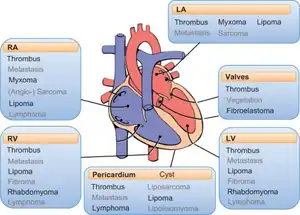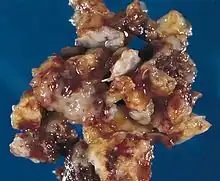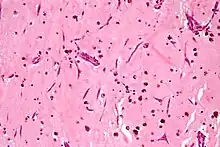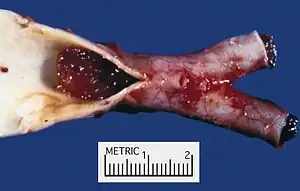Cardiac myxoma
| Atrial myxoma | |
|---|---|
| Other names: Myxoma[1] left atrial myxoma and atrial myxoma (not recommended)[1] | |
 | |
| Specialty | Cardiology |
| Complications | Embolism[2] |
| Diagnostic method | Transthoracic echocardiography[1] |
| Frequency | Rare[2] |
A cardiac myxoma is a noncancerous tumor of the heart that may embolise and grow at the site of embolisation.[1] Symptoms depend on the tumor size, location, shape, mobility and how fast it grows.[1] More than two-thirds have severe symptoms such as heart failure, stroke and embolisation.[3] Up to a fifth may have no symptoms.[1] Typical presentations include shortness of breath, feeling faint, chest pain, palpitations, fever, weight loss and joint pains.[1] There may be sudden death.[1]
Although any chamber may be affected, most arise within the left atrium near the valve of the fossa ovalis.[1] It may run in families as part of Carney syndrome, or may occur sporadically.[2] The tumor is derived from multipotent mesenchymal cells.[4]
It can affect adults between 30 and 60 years of age.[5] Diagnosis is by transthoracic echocardiography.[1]
It is rare.[2]
Signs and symptoms
Symptoms may occur at any time, but most often they accompany a change of body position. Pedunculated myxomata can have a "wrecking ball effect", as they lead to stasis and may eventually embolize themselves. Symptoms may include:[6]
- Shortness of breath with activity
- Platypnea – Difficulty breathing in the upright position with relief in the supine position
- Paroxysmal nocturnal dyspnea – Breathing difficulty when asleep
- Dizziness
- Fainting
- Palpitations – Sensation of feeling your heart beat
- Chest pain or tightness
- Sudden Death (In which case the disease is an autopsy finding)
The symptoms and signs of left atrial myxomata often mimic mitral stenosis. General symptoms may also be present, such as:[6]
- Cough
- Pulmonary edema – as blood backs up into the pulmonary artery, after increased pressures in the left atrium and atrial dilation
- Hemoptysis
- Fever
- Cachexia – Involuntary weight loss
- General discomfort (malaise)
- Joint pain
- Blue discoloration of the skin, especially the fingers change color upon pressure, cold, or stress (Raynaud's phenomenon)
- Clubbing – Curvature of nails accompanied with soft tissue enlargement of the fingers
- Swelling – any part of the body
- Presystolic heart murmur[7]
These general symptoms may also mimic those of infective endocarditis.
Complications
- Arrhythmias
- Pulmonary edema
- Peripheral emboli
- Spread (metastasis) of the tumor
- Blockage of the mitral heart valve
- Stroke
- Fusiform cerebral aneurysms
Causes
Myxomata are the most common type of adult primary heart tumor.[4] [8] Most myxomata arise sporadically (90%), and only about 10% are thought to arise due to inheritance.[9]
About 10% of myxomata are inherited, as in Carney syndrome. Such tumors are called familial myxomata. They tend to occur in more than one part of the heart at a time, and often cause symptoms at a younger age than other myxomata. Other abnormalities are observed in people with Carney syndrome include skin myxomata, pigmentation, endocrine hyperactivity, schwannomas and epithelioid blue nevi.[4] Myxomata are more common in women than men.[4][6]
Diagnosis


A doctor will listen to the heart with a stethoscope. A "tumor plop" (a sound related to movement of the tumor), abnormal heart sounds, or a murmur similar to the mid-diastolic rumble of mitral stenosis may be heard. These sounds may change when the patient changes position.[10]
Right atrial myxomata rarely produce symptoms until they have grown to be at least 13 cm (about 5 inches) wide.
Tests may include:[11]
- Echocardiogram and Doppler study
- Chest x-ray
- CT scan of chest
- Heart MRI
- Left heart angiography
- Right heart angiography
- ECG—may show atrial fibrillation
Blood tests:
- Blood tests: A FBC may show anemia and increased WBCs (white blood cells). The erythrocyte sedimentation rate (ESR) is usually increased.
- Blood tests: A FBC may show anemia and increased WBCs (white blood cells). The erythrocyte sedimentation rate (ESR) is usually increased.
 Echocardiogram of atrial myxoma
Echocardiogram of atrial myxoma- Echocardiogram showing atrial myxoma[12]
 Echocardiogram showing atrial myxoma[12]
Echocardiogram showing atrial myxoma[12]
 Atrial myxoma and myocardium. H&E stain.
Atrial myxoma and myocardium. H&E stain. Atrial myxoma. H&E stain.
Atrial myxoma. H&E stain. Atrial myxoma. H&E stain.
Atrial myxoma. H&E stain. Atrial myxoma covered by endothelium. H&E stain.
Atrial myxoma covered by endothelium. H&E stain.
Treatment
The surgery is treatment of choice,[13] tumor must be surgically removed. Some patients will also need their mitral valve replaced. This can be done during the same surgery. Usually, inadequate excision of the tumor, development from a secondary focus, or intracardiac implantation from the primary tumor are the attributable explanation for recurrence,[14] and it is more likely to occur in the first 10 postoperative years, especially in younger patients.[15]
Prognosis

Although a myxoma is not malignant with risk of metastasis,[6] complications are common. Untreated, a myxoma can lead to an embolism (tumor cells breaking off and traveling with the bloodstream). Myxoma fragments can move to the brain, eye, or limbs.
If the tumor continues to enlarge inside the heart, it can block blood flow through the mitral valve and cause symptoms of mitral stenosis or mitral regurgitation. This may require emergency surgery to prevent sudden death.[16]
See also
- Myxoma
- Interleukin 6
- Papillary fibroelastoma
- Rhabdomyomas
- Cardiac sarcomas
References
- 1 2 3 4 5 6 7 8 9 10 WHO Classification of Tumours Editorial Board (2021). "3. Tumours of the heart: cardiac myxoma". Thoracic Tumours. Vol. 5 (5th ed.). Lyon (France): World Health Organization. pp. 233–236. ISBN 978-92-832-4506-3. Archived from the original on 2022-05-14. Retrieved 2022-07-23.
- 1 2 3 4 Islam, AKMM (26 April 2022). "Cardiac myxomas: A narrative review". World Journal of Cardiology. 14 (4): 206–219. doi:10.4330/wjc.v14.i4.206. PMID 35582466. Archived from the original on 24 July 2022. Retrieved 24 July 2022.
- ↑ Maleszewski, Joseph J.; Basso, Cristina; Bois, Melanie C.; Glass, Carolyn; Klarich, Kyle W.; Leduc, Charles; Padera, Robert F.; Tavora, Fabio (April 2022). "The 2021 WHO Classification of Tumors of the Heart". Journal of Thoracic Oncology: Official Publication of the International Association for the Study of Lung Cancer. 17 (4): 510–518. doi:10.1016/j.jtho.2021.10.021. ISSN 1556-1380. PMID 34774791. Archived from the original on 2022-07-24. Retrieved 2022-07-24.
- 1 2 3 4 Hecht, Sisalee M. (2009-10-27). "A Review of: "Current Diagnosis & Treatment: Cardiology. 3rd ed. Crawford, Michael H., ed."". Medical Reference Services Quarterly. 28 (4): 401–402. doi:10.1080/02763860903249993. ISSN 0276-3869. S2CID 73897596.
- ↑ Velez Torres, Jaylou M.; Martinez Duarte, Ernesto; Diaz-Perez, Julio A.; Rosenberg, Andrew E. (November 2020). "Cardiac Myxoma: Review and Update of Contemporary Immunohistochemical Markers and Molecular Pathology". Advances in Anatomic Pathology. 27 (6): 380–384. doi:10.1097/PAP.0000000000000275. ISSN 1072-4109. PMID 32732585. S2CID 220892586. Archived from the original on 2022-07-24. Retrieved 2022-07-19.
- 1 2 3 4 Aiello, Vera Demarchi; Campos, Fernando Peixoto Ferraz de (2016). "Cardiac Myxoma". Autopsy & Case Reports. 6 (2): 5–7. doi:10.4322/acr.2016.030. ISSN 2236-1960. PMC 4982778. PMID 27547737.
- ↑ Eric J. Topol. The Topol Solution: Textbook of Cardiovascular Medicine Archived 2020-01-02 at the Wayback Machine, Third Edition with DVD, Plus Integrated Content Website, Volume 355. Lippincott Williams & Wilkins, Oct 19, 2006; page 223. ISBN 0781770122
- ↑ Vaideeswar, P.; Butany, JW. (Feb 2008). "Benign cardiac tumors of the pluripotent mesenchyme". Semin Diagn Pathol. 25 (1): 20–8. doi:10.1053/j.semdp.2007.10.005. PMID 18350919.
- ↑ Masters, Barry R. (2012-05-25). "Harrisons's Principles of Internal Medicine, 18th Edition, two volumes and DVD. Eds: Dan L. Longo, Anthony S. Fauci, Dennis L. Kasper, Stephen L. Hauser, J. Larry Jameson and Joseph Loscalzo, ISBN 9780071748896 McGraw Hill". Graefe's Archive for Clinical and Experimental Ophthalmology. 250 (9): 1407–1408. doi:10.1007/s00417-012-1940-9. ISSN 0721-832X. S2CID 11647732.
- ↑ "Cardiac Myxoma". The Lecturio Medical Concept Library. Archived from the original on 9 July 2021. Retrieved 6 July 2021.
- ↑ "Cardiac Myxoma". The Lecturio Medical Concept Library. Archived from the original on 9 July 2021. Retrieved 6 July 2021.
- 1 2 "UOTW #31 - Ultrasound of the Week". Ultrasound of the Week. 30 December 2014. Archived from the original on 26 March 2020. Retrieved 27 May 2017.
- ↑ Lone RA, Ahanger AG, Singh S, Mehmood W, Shah S, Lone G, Dar A, Bhat M, Sharma M, Lateef W. Atrial myxoma: trends in management. Int J Health Sci (Qassim). 2008 Jul;2(2):141-51. PMID: 21475496; PMCID: PMC3068734.
- ↑ Sheng WB, Luo BE, Liu Y, Zhang H, Zou LJ, Xu ZY, Zhang HY, Ji GY. Risk factors for postoperative recurrence of cardiac myxoma and the clinical managements: a report of 5 cases in one center and review of literature. Chin Med J (Engl). 2012 Aug;125(16):2914-8. PMID: 22932090.
- ↑ Shah IK, Dearani JA, Daly RC, Suri RM, Park SJ, Joyce LD, Li Z, Schaff HV. Cardiac Myxomas: A 50-Year Experience With Resection and Analysis of Risk Factors for Recurrence. Ann Thorac Surg. 2015 Aug;100(2):495-500. doi: 10.1016/j.athoracsur.2015.03.007. Epub 2015 Jun 9. PMID: 26070596.
- ↑ "A Biatrial Myxoma with Triple Ripples". Archived from the original on 2018-04-07. Retrieved 2022-07-19.
External links
| Classification | |
|---|---|
| External resources |